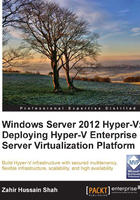
Introduction
We welcome you on board to our journey of discovering Microsoft Windows Server 2012 Hyper-V. As we speak, the current version of Hyper-V is Windows Server 2012. In this book we will cover all aspects of Hyper-V as an enterprise server virtualization platform. Since Hyper-V is a server role inside the Windows Server operating system, while we make our journey of discovering Hyper-V basic fundamentals and new features, we will also be covering numerous new features added into Windows Server 2012. Throughout this book our goal will be not only to cover the theory of Hyper-V or Windows Server, but also to provide you with knowledge about real-world scenarios, best practices, tips, and last but not least recommendations from field experience. In addition to all this, we will see the screenshots of step-by-step setting of Hyper-V basic and advanced configuration. This will provide you enough guidance to start your first server virtualization and consolidation project with Hyper-V. Or if you are already running an existing virtualization platform with Hyper-V, after completing this book you will become capable of upgrading your existing Hyper-V server to new Windows Server 2012 for utilizing various brand-new out-of-the-box server-virtualization features, which currently none of the other hypervisor products deliver.
Okay, we now know what we are going to see in this book, and before we go deeper in Hyper-V and discuss all its bits and pieces, let's first get introduced to few of the basic concepts and theories on which we build server virtualization. I would like to first introduce you to a few of the important concepts such as virtualization, server consolidation, and cloud computing. All these concepts are essential for us to build our underlying understanding for moving forward with each new chapter that we cover in this book.